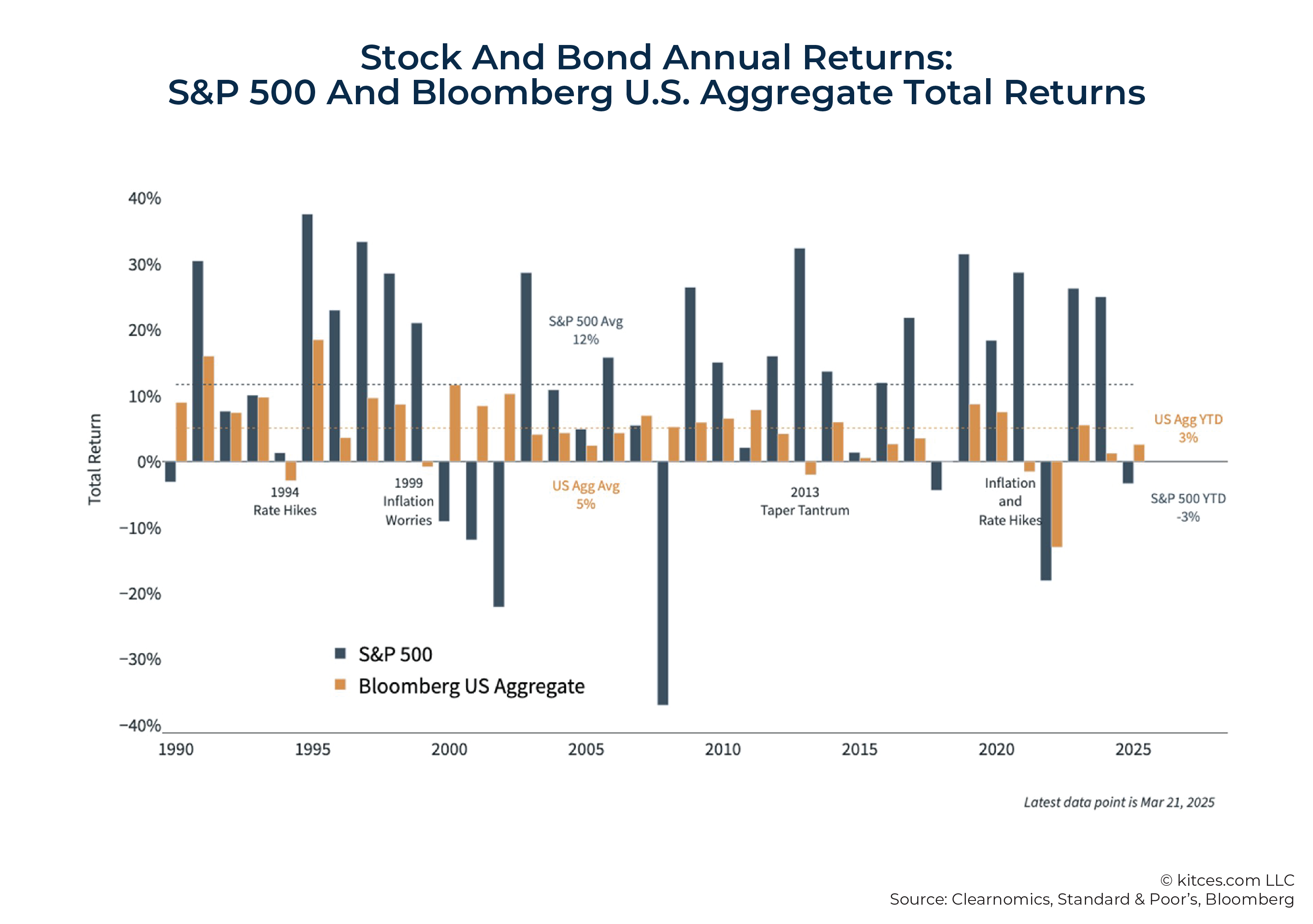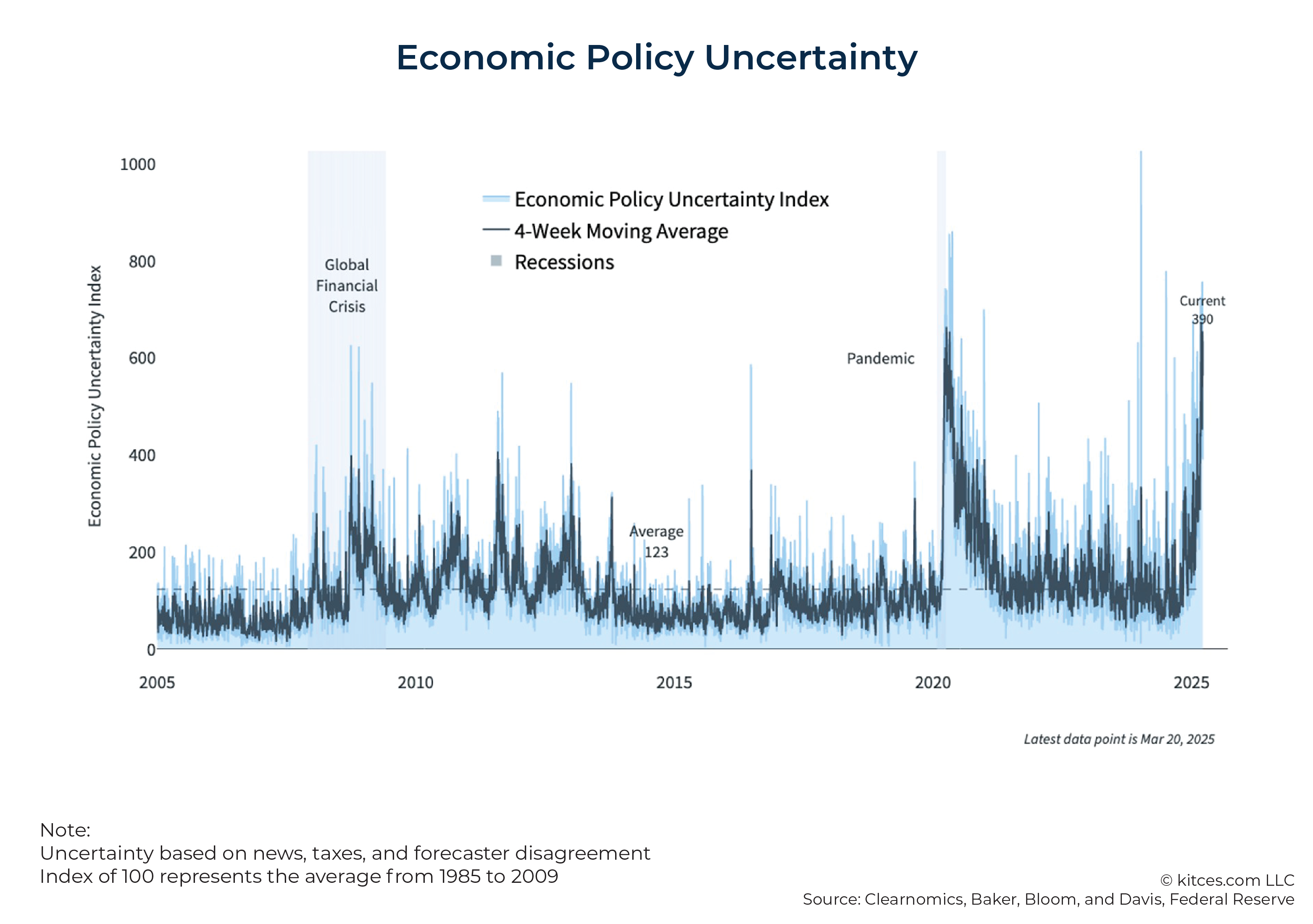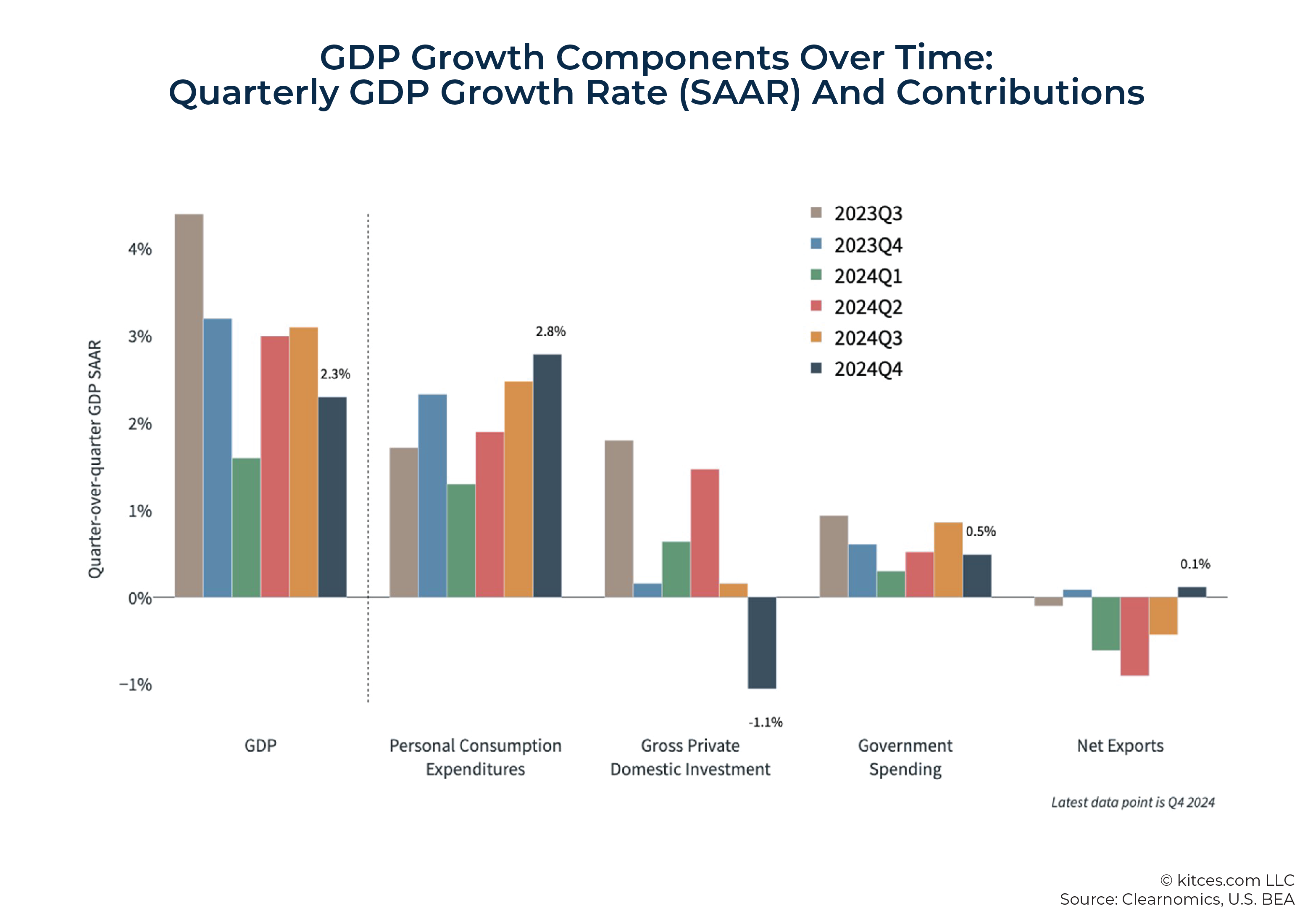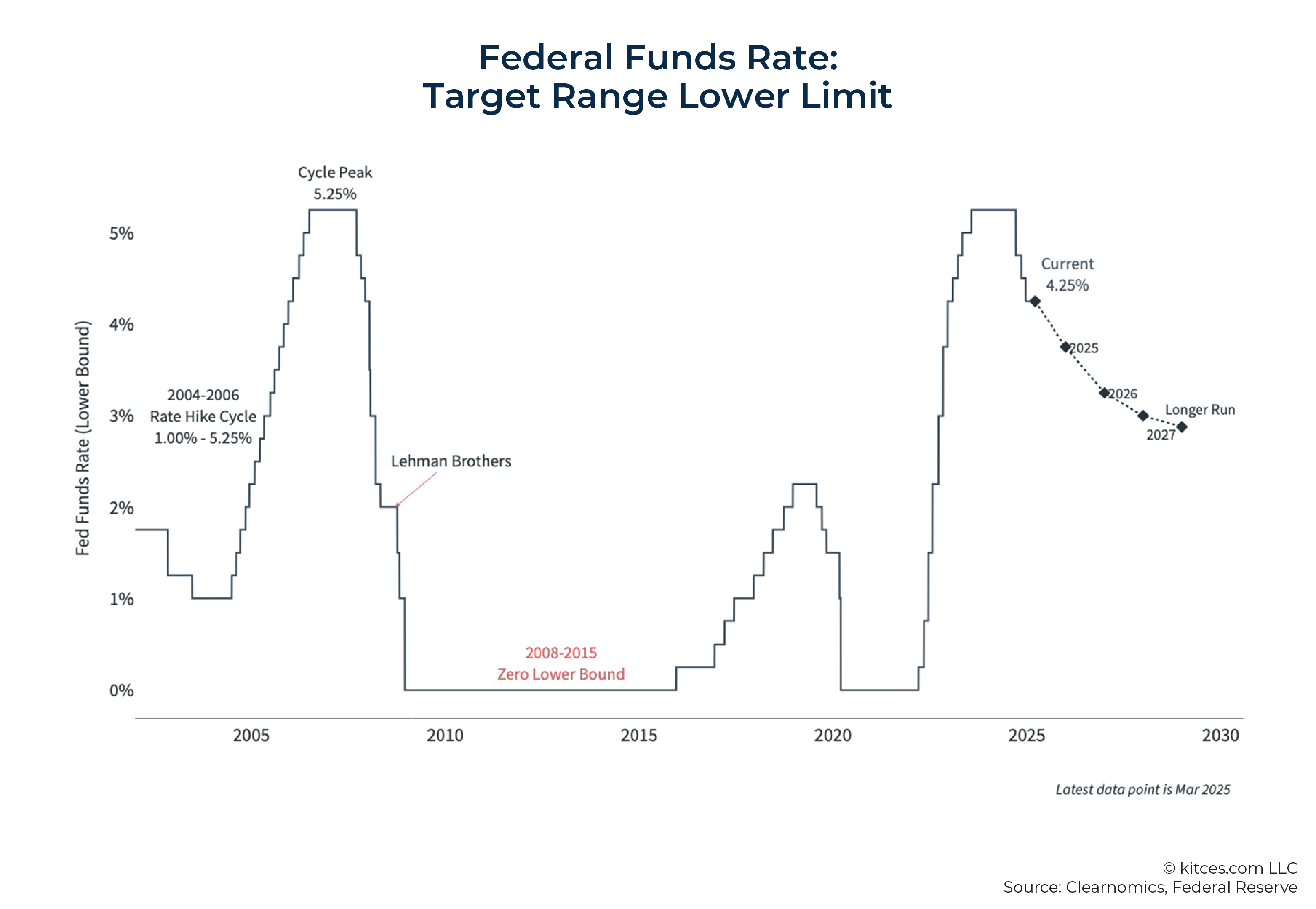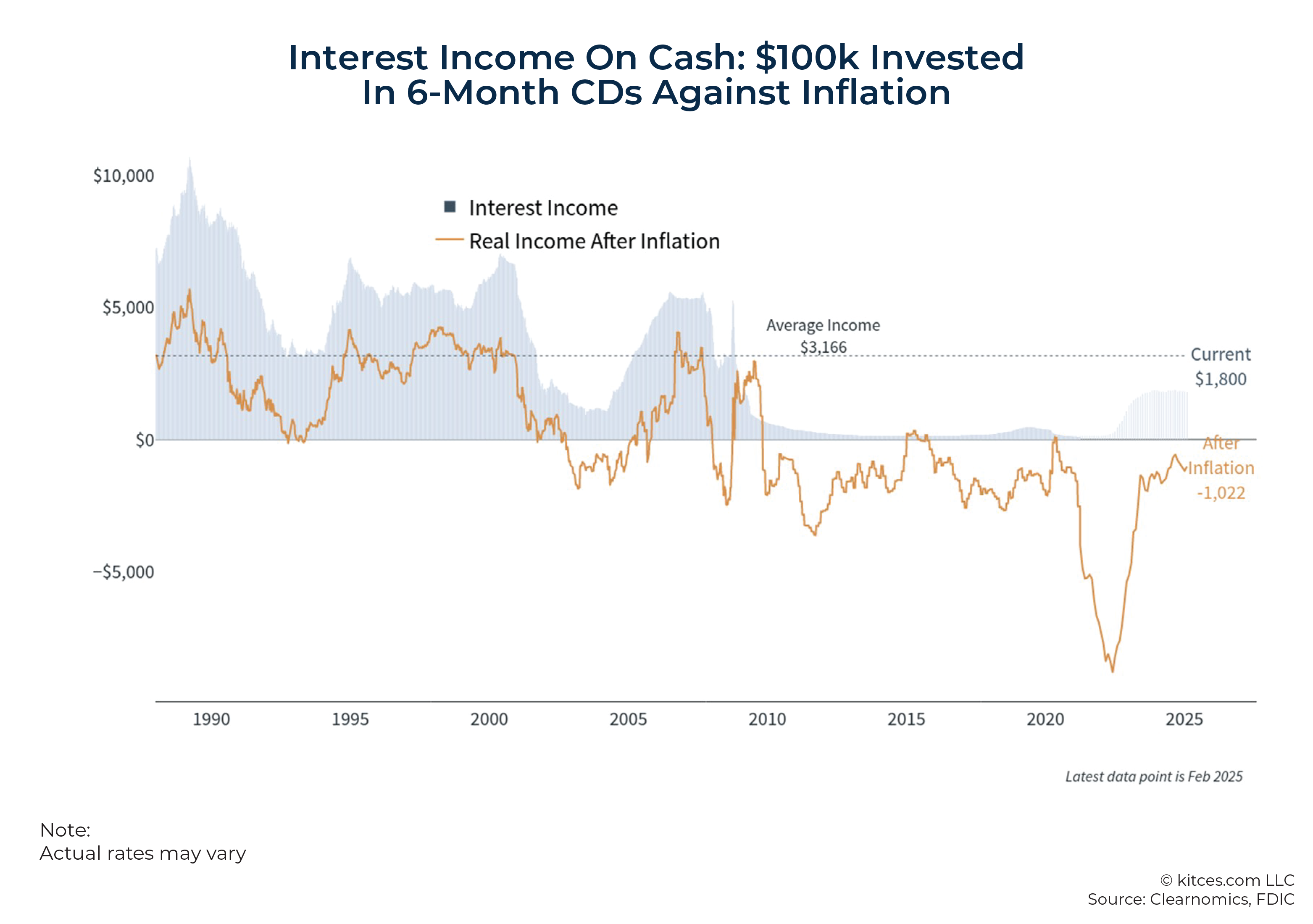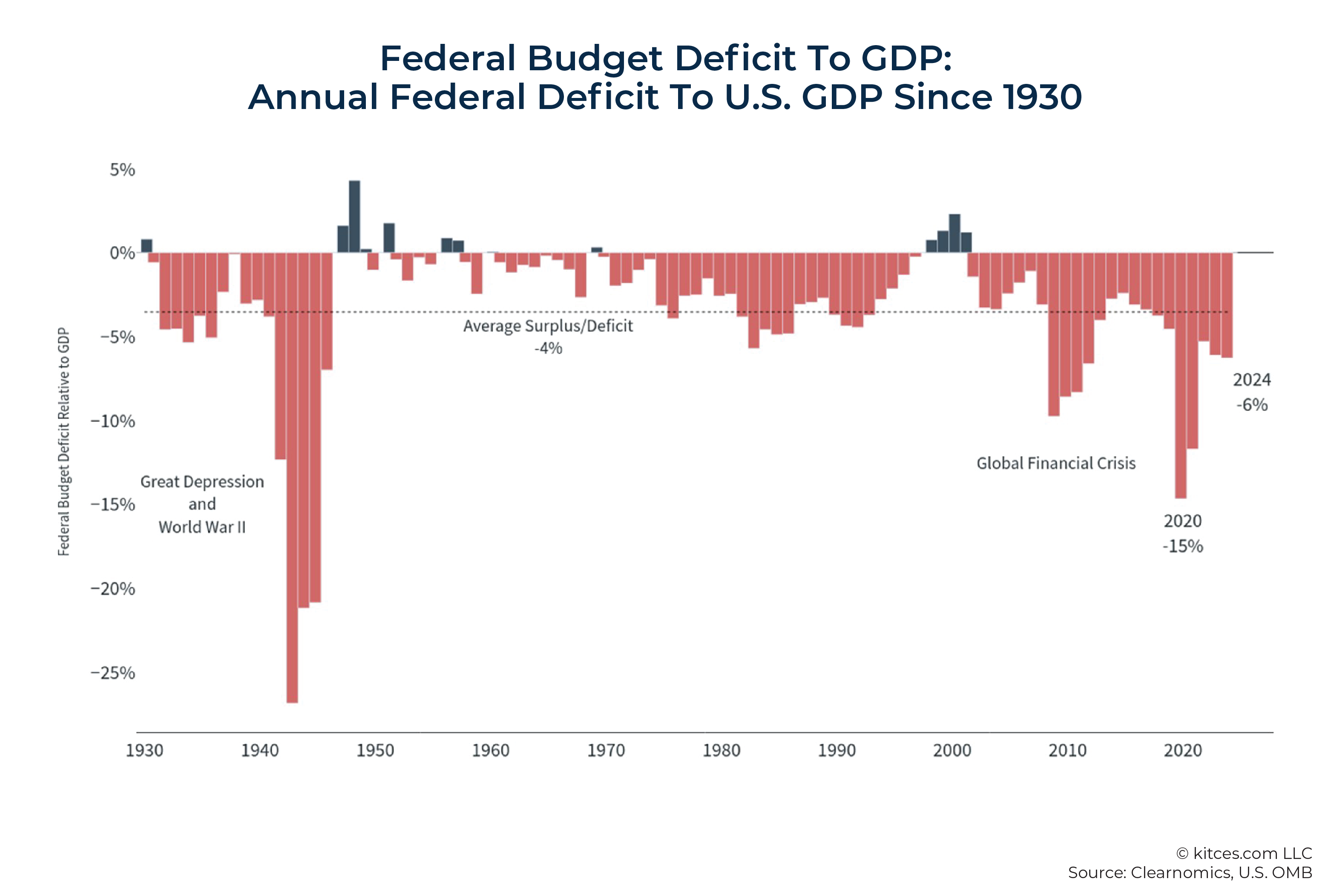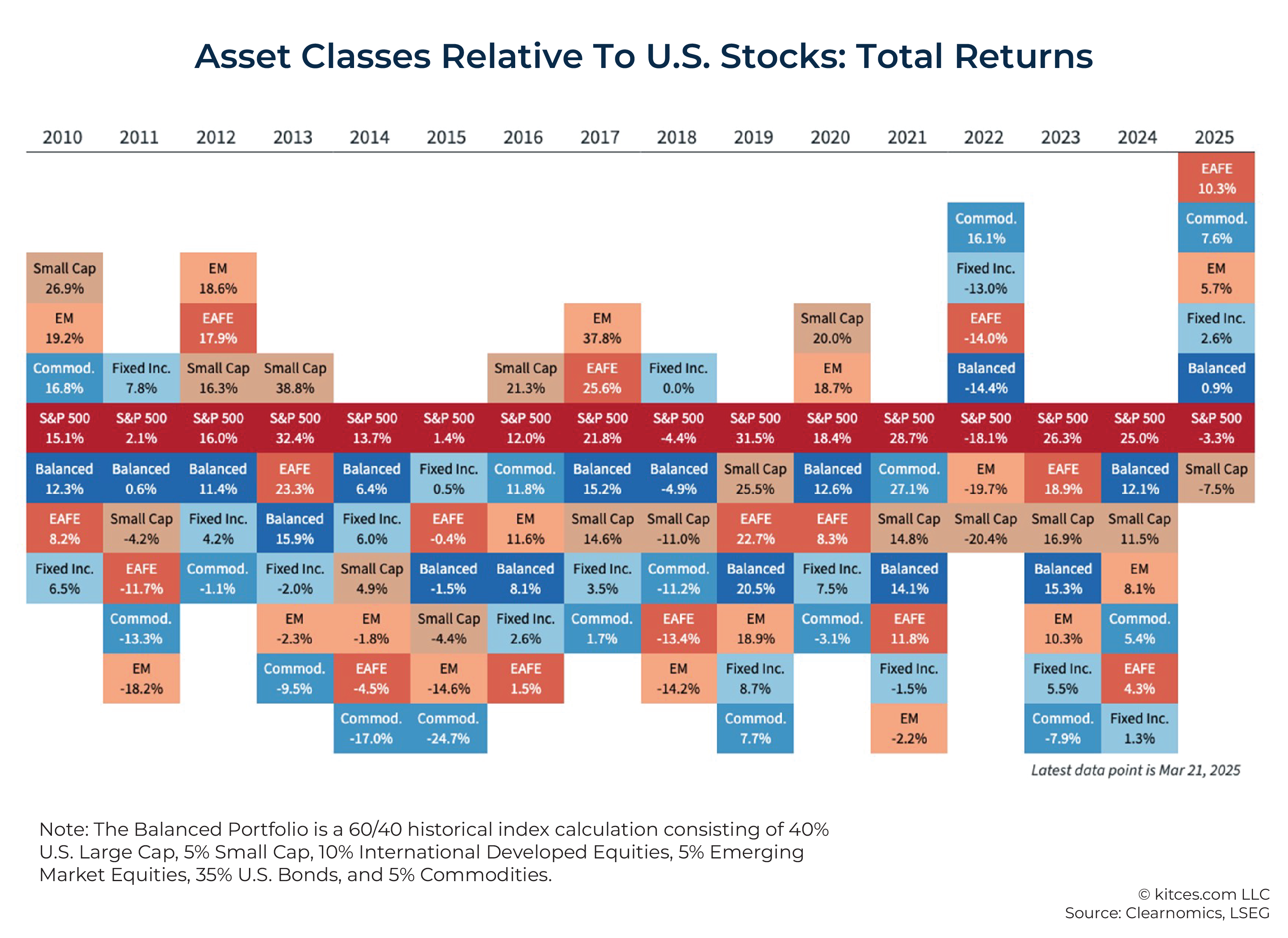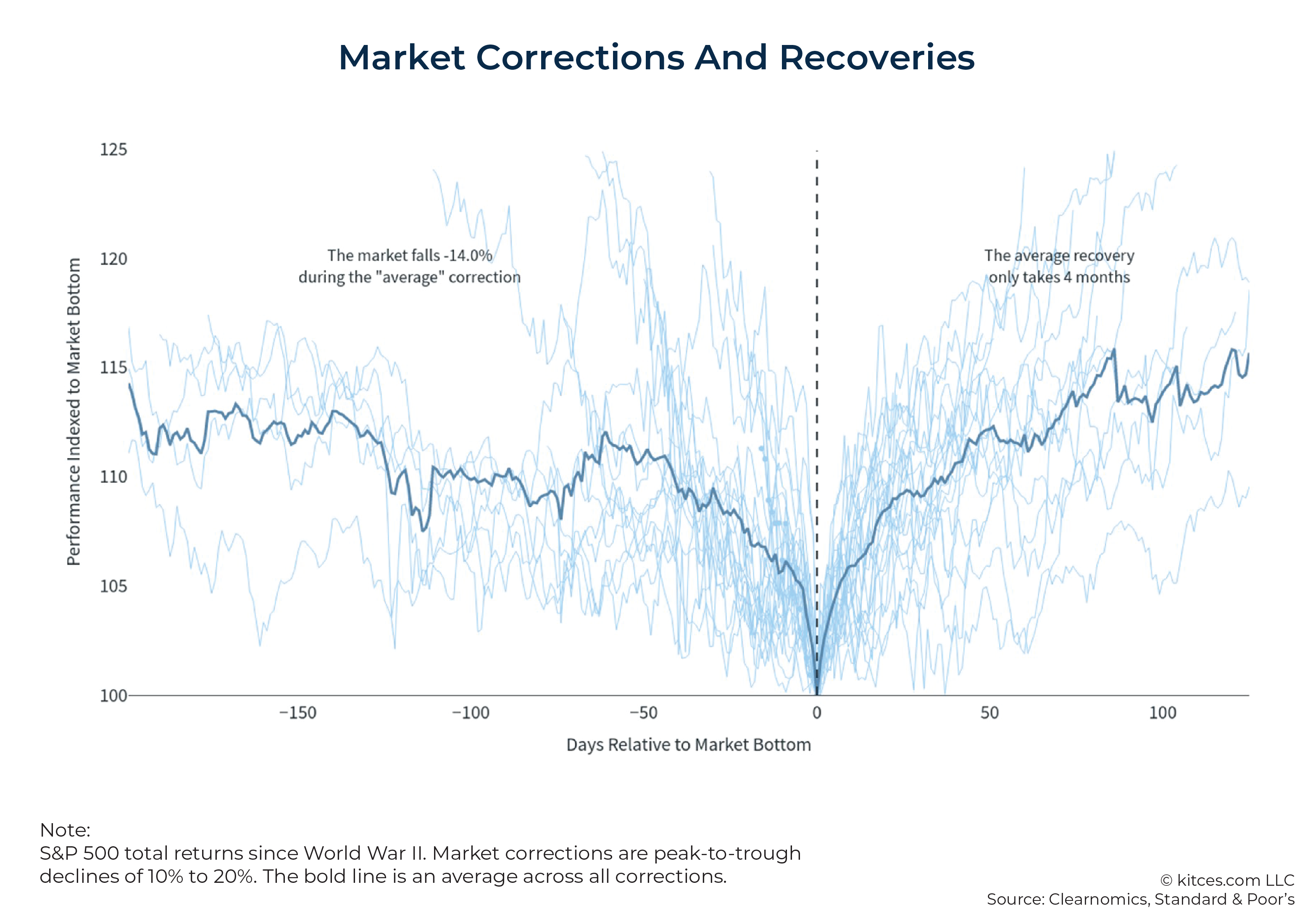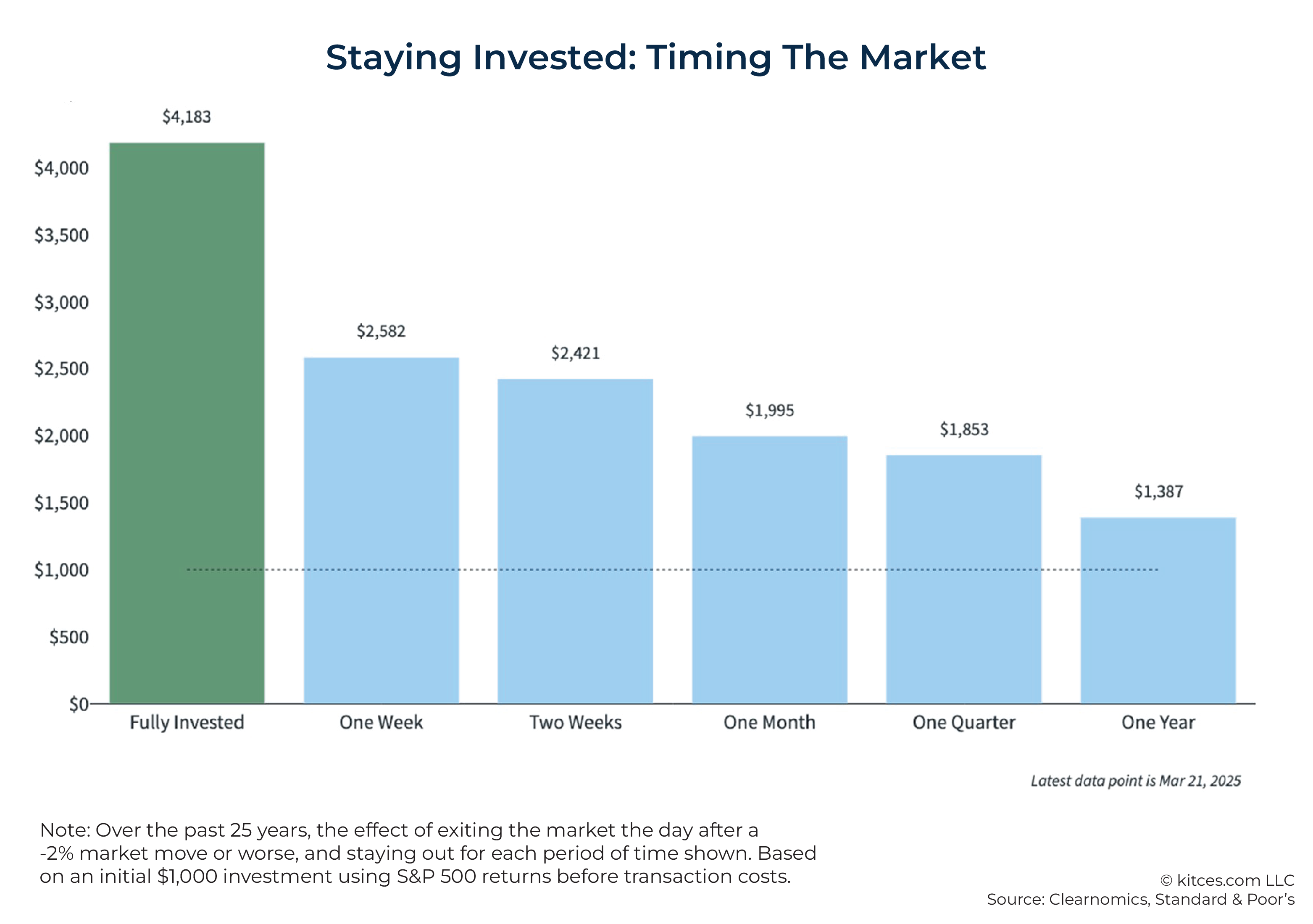Executive Summary
While financial markets tend to rise in the long run, short-term volatility can be alarming for investors. Recent swings have been driven by economic policy shifts, persistent inflation concerns, and geopolitical uncertainty – all of which may unnerve even the steadiest of clients. During turbulent periods like these, advisors play a critical role in helping clients maintain perspective and stay grounded.
In this article, James Liu, CEO and founder of Clearnomics, and Lindsey Bell, the firm's Chief Market Strategist, present ten charts to help advisors contextualize the current market environment. Each visual is paired with talking points designed to help advisors reframe volatility in a way that speaks to clients' concerns.
As a starting point, it's helpful to reinforce that investing success isn't about timing the market or picking winning stocks, sectors, or asset classes. Rather, it's about constructing a portfolio that aligns with a client's long-term goals. While stocks have recently declined, bond yields are above historical averages – highlighting the importance of maintaining a diversified mix. And while cash can feel safe, it often fails to keep pace with inflation, especially in turbulent markets. In that same vein, diversification remains the core of a healthy portfolio to protect against market corrections and underperformance, as no single asset class outperforms indefinitely.
It may also be helpful to discuss the drivers of current market corrections. Advisors might acknowledge that inflation and political uncertainty often elicit market reactions, and that many economic policy decisions can be controversial and divide public opinion. Nevertheless, history shows that markets have performed well under both political parties. Much of what's happening now reflects companies adapting to present-day challenges – from higher input costs to shifting consumer demand. Advisors can guide clients' attention to where growth is happening and to areas of economic resilience – such as persistently low unemployment – that are often overlooked in negative news cycles.
Finally, advisors can emphasize that while market corrections never feel good, they are a natural part of the investing cycle – just like market recoveries. And because recoveries are difficult to time, the best thing investors can do is to stay the course and focus on long-term goals. Advisors are uniquely positioned to offer not only perspective and education, but also empathy and reassurance during tough market periods when clients may need it most.
The key point is that challenging market environments give advisors the opportunity to tailor talking points to a client's specific anxieties. Being well-informed about the market influences, remaining empathetic, and maintaining a long-term perspective are all crucial to guiding clients through market corrections. And, while unpleasant, tough market conditions offer a way for advisors to explain the critical role of a well-diversified portfolio, demonstrate their knowledge, and ultimately affirm their long-term value!
The author F. Scott Fitzgerald once wrote that "the test of a first-rate intelligence is the ability to hold two opposed ideas in the mind at the same time, and still retain the ability to function." This concept is particularly relevant for investors, who must navigate the tension between short-term market fluctuations and long-term financial goals on a regular basis – especially in today's uncertain environment.
Markets can swing dramatically in the short run, even as they tend to rise in the long run. Investor sentiment can shift overnight, as seen several times in recent months. An underperforming sector, investment style, or asset class can suddenly surge to the top, while previous market leaders fall out of favor. Meanwhile, the economy often provides mixed signals that can seem contradictory – especially when fiscal and monetary policies are shifting in response to evolving conditions.
The best way to help clients make sense of these contradictions is to provide perspective. When investors can simultaneously acknowledge short-term uncertainties and maintain confidence in their long-term financial plans, they are better positioned to avoid emotional decisions that could derail their financial goals. Advisors play a critical role in providing that perspective to help clients navigate this balancing act by communicating clearly and reinforcing client trust.
Why is this important today? Recent market volatility, economic policy shifts, persistent inflation concerns, and geopolitical risks have created an atmosphere of uncertainty. For financial advisors guiding clients through these turbulent times, providing context and perspective is more important than ever to help clients stay grounded in their financial plans rather than reacting impulsively to headlines.
To support advisors with client-friendly talking points, we've compiled a set of ten key charts that offer valuable insights into current market conditions and economic trends. These visuals serve as a resource for discussing market movements with clients in a way that reinforces long-term investment principles, which can help clients stay invested through periods of uncertainty.
For those interested, these Clearnomics charts can be accessed here as a downloadable PDF. By leveraging visual storytelling and client-friendly messaging, advisors can help investors stay focused on their financial future – rather than getting caught up in short-term uncertainty.
Chart 1. Stocks Have Struggled This Year, But Bonds Have Provided Balance
The stock market has stumbled after two exceptional years. The S&P 500 recently fell into correction territory, led by declines in the Nasdaq and major technology stocks. While tariffs sparked this latest wave of volatility, investors are now concerned about a possible recession. Given the headlines, it's not hard to see why some investors are nervous.
Market downturns are never pleasant, but perspective is key. Despite recent volatility, the S&P 500 has generated a total return of around 60% (including reinvested dividends) since the market bottom in 2022, while the Nasdaq has gained over 70% during the same period. Large technology and artificial intelligence stocks, including the Magnificent 7, have risen over 400% since the start of 2020, even after the latest declines.
Just a year ago, many investors were worried about an immediate 'hard landing' due to the risk of a Fed policy mistake. Instead, the S&P 500 gained over 25% in 2024 despite two major pullbacks. The market rebounds of 2022, 2020, and countless other past downturns show how headlines often diverge from actual long-term market performance. While the past is never a guarantee of the future, these examples underscore how important it is to remind clients that market swings are a normal part of investing.
Proper investing isn't about timing the market or picking a winning stock, sector, or asset class. Instead, it's about constructing a portfolio that is aligned with long-term financial goals. Stocks have clearly faced a challenging few months; however, bonds have provided important portfolio support this year – a marked contrast to 2022, when stock-bond correlations ran high due to inflation concerns. Bond yields remain attractive, with the 10-year Treasury yield at approximately 4.3% and investment-grade corporate bonds yielding 5.2% on average, well above their levels since the 2008 financial crisis. After a difficult five-year period for bonds, this is welcome news for diversified investors.
One reason for stock market fragility is that valuations are no longer cheap. The S&P 500 Price-to-Earnings (P/E) ratio, for instance, is 20.2 times next-12-month earnings, which is above the long-term average. In this environment, diversification across various market segments, including value stocks, international equities, and fixed income, can help manage risk while positioning portfolios for long-term growth. In today's context, a good example is sector rotation, with Utilities and Financials becoming the best performers over the past year. For some investors, this was unexpected given the outperformance of technology and artificial intelligence stocks over the previous few years.
Higher interest rates can also make stocks less attractive relative to other investments. This is often measured by the equity risk premium – the additional return that investors demand for taking on the risk of equities over lower-risk assets. With both stock market valuations and interest rates remaining high, the equity risk premium has fallen in recent years, adding another layer of complexity to portfolio construction.
For investors, the key takeaway is that market leadership is continually evolving. Stocks and bonds have a long history of providing diversification benefits, and 2025 is another example of bonds supporting a balanced investor. Today's underperforming assets can become tomorrow's outperformers, reinforcing the importance of maintaining a well-diversified portfolio aligned with long-term financial goals as the best foundation for navigating all parts of the cycle.
Chart 2. Markets Are Worried About Economic Policy Uncertainty
For many clients, concerns around economic policy have heightened fears of a potential recession. This issue has become a major talking point again in 2025, with investor sentiment falling near record lows according to the weekly AAII Investor Sentiment Survey.
One interesting way to visualize this market concern is through the Economic Policy Uncertainty Index, which is calculated based on news coverage of policy changes, disagreement among economic forecasters, and expiring Federal tax code provisions. This index is normalized to 100 using the average from 1985 to 2009 to allow for easy comparison to a long historical period that included many policy and economic uncertainties. The significant jump this year is the result of tariffs and other fiscal and economic policies being quickly implemented by the Trump administration.
When discussing policy uncertainty with clients, it's important to acknowledge that many economic policies can be controversial, and approximately half of the country will likely not agree with their direction. However, history shows that markets and the economy have performed well under both political parties. What matters more is the underlying business cycle, economic fundamentals, and how companies adapt to changing conditions – rather than which party is currently in power.
Regardless of political views, markets dislike uncertainty, and recent policy shifts have created questions about future economic growth. Tariff concerns have been particularly prominent, with investors worried about a potential trade war and its impact on consumer prices and supply chains. The Trump administration has acknowledged the possibility of economic turbulence during these policy shifts and has not ruled out the potential for a recession.
What does this mean for long-term investors? Once again, a broader perspective is helpful. Only a few months ago, markets were enthusiastic about the potential for pro-growth policies, many of which are still on the table. For instance, the possible extension of the Tax Cuts and Jobs Act is currently working its way through Congress. Furthermore, the recent government spending agreement that avoided a government shutdown is a positive sign that new bills can be passed.
Markets have historically adapted to policy changes over time. During President Trump's first term, concerns about tariffs and trade wars rattled markets until investors adjusted their expectations. Despite this, markets generally performed quite well, especially once trade agreements were reached. Tariffs also frequently serve as negotiation tools for broader policy goals such as border control.
Understanding that current market swings are driven by policy uncertainty rather than actual economic weakness can help put recent volatility in perspective. The situation can often improve once uncertainty is lifted and concrete policies are implemented.
Chart 3. Inflation Continues To Drive Policy Decisions
It's difficult to overstate how significant a role inflation has played over the past few years, given its impact on consumers and businesses and its influence on Fed policy. Rising prices forced the central bank to rapidly hike rates beginning in 2022. As inflation eased, the Fed reduced policy rates in 2024. However, in 2025, inflation has been more stubborn than the Fed would like, putting further cuts on hold.
Discussing inflation with clients can be tricky due to differences between what we experience personally as consumers and what matters to the broader market and economy. Prices of everyday essentials like gasoline, food, shelter, and other necessities have a direct impact on our personal finances and lifestyles as individuals. And when these prices rise sharply, clients may feel inflation more acutely than the official government numbers suggest.
In some cases, discussing "core" inflation measures, which exclude the important but volatile categories of food and energy, can seem odd to clients. Even more extreme are "supercore" measures, which exclude additional categories, such as housing costs. However, these measures help reveal the underlying trends in inflation that influence monetary policy. Since some price categories naturally rise and fall on a monthly basis due to changing commodity prices, for example, economists and policymakers often rely on these adjusted measures to understand the persistent components of inflation.
The two most closely watched inflation indicators currently remain above the Fed's official long-run inflation target of 2.0%:
- Consumer Price Index (CPI): Decelerated slightly to 2.8% year-over-year in February after rising for two months.
- Producer Price Index (PPI): Slowed to 3.2% year-over-year, a substantial improvement from January. This index can be a leading indicator of consumer prices.
Higher inflation means that the Fed may need to delay additional rate cuts longer than some investors would like.
The inflation picture is particularly important in the context of new tariffs, which could add upward pressure on the prices of consumer goods. Historically, tariffs have led to price increases in imported goods, as demonstrated when washing machine prices rose following the 2018 tariff implementation. Since many consumer products contain components that are manufactured abroad, tariffs can also drive the costs of most domestically assembled goods higher. And when businesses face higher import costs due to tariffs, they must choose between absorbing these costs, negotiating with suppliers, or passing expenses on to consumers.
Consumers are naturally sensitive to higher prices after the experience of high inflation over the past few years. According to the University of Michigan Surveys of Consumers, overall consumer sentiment declined to 57.9 in March 2025, down from a high of 79.4 a year ago and is approaching the historic low of 50.0 in mid-2022. Much of this is driven by the expectation among consumers that inflation could rise as high as 4.9% in the coming year.
Chart 4. GDP Growth Components Can Provide Perspective On The Full Economic Picture
When explaining this year's mixed economic data to clients, it can be helpful to break down economic growth into its key components: consumer spending, business investment, government spending, and trade. This chart shows each of these categories over the past several quarters.
It's easy to see that consumer spending has been the primary driver of GDP growth over this period. This highlights the resilience of American households despite higher interest rates, inflation concerns, and recession fears.
One factor that has helped offset these challenges is the strong job market. The unemployment rate of 4.1% remains near historic lows, with 7.7 million job openings – more than one job for each unemployed individual. Having job prospects may help bolster consumer confidence and spending in spite of recent economic uncertainty.
While many investors hope that pro-growth policies will stimulate increased business investment (gross private domestic investment), significant growth in this area has yet to materialize. Meanwhile, government spending is projected to decline as the administration implements efficiency measures, including the Department Of Government Efficiency (DOGE) initiatives aimed at reducing Federal expenditures.
The broader perspective is that GDP has grown at a real annualized rate of 3% or more in five of the past ten quarters. GDP growth decelerated to 2.3% in the fourth quarter of 2024 as inventories were reduced, but this is still a healthy rate. By contrast, it was only a decade ago when 'secular stagnation' was widely accepted as the long-term trajectory for the US. Instead, consumer spending, productivity growth, and innovation have helped to keep the economy growing.
What does this mean looking ahead? The path of economic growth will likely depend on whether policy changes can successfully stimulate business investment. The changing composition of economic growth illustrates how different sectors of the economy can contribute to expansion across different phases of the cycle.
Chart 5. Markets Still Expect Additional Fed Rate Cuts In 2025
While markets have focused on economic policy in recent months, the Fed has taken a pause on rate adjustments. Stubborn inflation, the strong job market, and ongoing economic uncertainty have led the Fed to take a 'wait-and-see' approach.
Market-based forecasts now suggest the Fed could implement another two to three rate cuts in 2025, reflecting confidence that inflation will subside. However, it's important to put market expectations in perspective. These expectations, which are based on the pricing of fed funds futures, can change quickly. At the start of 2024, for example, investors anticipated seven to eight Fed rate cuts in the wake of slowing inflation before adjusting to zero rate cuts. In the end, three cuts were implemented. Even the Fed's own rate forecasts from its Summary of Economic Projections can undergo meaningful changes each quarter.
Given that the actual path of rates is hard to predict accurately, it's important for clients not to focus too much on individual rate changes. That said, the path of policy rates is still likely to be lower. Historically, declining rates have helped support markets and the economy by making it easier for businesses and consumers to borrow, boosting economic activity.
Of course, long-term bond yields are also influenced by more than just Fed policy. Inflation expectations, economic growth forecasts, and global capital flows all play a role in determining yields. Recent fluctuations demonstrate how sensitive rates can be to policy shifts. Despite this, bond yields have generally remained elevated, with the 10-year US Treasury yield consistently remaining above 4%.
This higher-rate environment provides an important counterbalance to stock market volatility. Even if the Fed keeps rates higher for longer, bond investors are better positioned than they have been over the past decade. Ultimately, stable but elevated interest rates reflect a market that sees both persistent inflation and economic resilience.
Chart 6. Cash Feels Safe, But Can Be Counterproductive
It's understandable that, in this volatile environment, investors are retreating to the perceived safety of cash. Unlike stocks or bonds, cash holdings appear stable, offering a sense of security. However, this safety is often an illusion when viewed through a long-term financial lens.
It's important to educate clients on the major challenges facing cash-heavy portfolios in 2025. First, while inflation has improved, it continues to erode the purchasing power of cash. As the chart above shows, the inflation-adjusted income on cash invested in 6-month CDs is still negative, on average. This is even more true for funds held in conventional checking or savings accounts.
This is a hidden cost when investors seek the safety of cash. The balance on a bank statement may feel safe since it's stable, unlike the fluctuating value in an investment account. However, what truly matters isn't the dollar amount of cash but what it can purchase. Over time, inflation reduces purchasing power, meaning that the same number of dollars buys fewer goods and services each year. Thus, portfolio growth is needed to keep an investor's purchasing power at par, let alone to create real wealth.
Second, while interest rates are higher, many traditional cash vehicles still offer inadequate returns. These rates can vary significantly, with the national average rates for 12-month CDs remaining disappointing at just 0.14%, meaning a $1,000 deposit would yield only $1.40 over a year. While there are higher-yielding cash vehicles available, investors often find themselves in unexpected situations when rates change unexpectedly, such as when CDs roll over at lower rates.
Perhaps most critically for long-term investors, excessive cash allocations can compromise financial goals. In financial planning, cash is just one component of a broader asset allocation strategy. The optimal approach differs for each client but will likely combine cash with stocks, bonds, and alternative investments to achieve a balanced risk-reward profile that aligns with individual financial objectives.
Ultimately, while cash is an important part of any portfolio, its value depends on how it is used. A well-managed cash reserve provides stability for short-term needs and emergencies, but holding too much can erode purchasing power and limit long-term growth. Having the discipline to save enough cash in the first place is the first step toward financial freedom. Investing that cash in the right portfolio is what grows savings into real wealth.
Chart 7. The Government Deficit Remains A Significant Investor Concern
Fiscal debates about the debt, deficit, and budgets are a mainstay in Washington. They have become a more frequent topic of discussion following the Trump administration's establishment of DOGE, whose mandate is to reduce government spending and improve economic efficiency.
This can be a challenging topic to discuss with clients, as personal and political views on government fiscal policy can often differ from investment considerations. As citizens, voters, and taxpayers, individuals may hold strong opinions on spending and taxation and their implications for the country over the coming generations. These debates have been a recurring issue with debt ceilings, budget deadlines, and deficits multiple times a year.
However, when it comes to investing and financial planning, it's important to distinguish political concerns from market realities and whether the Federal debt directly or indirectly impacts the economy and markets. While the national debt is a significant issue, history has shown that markets have generated strong returns over the past two economic cycles. Ironically, deficits are the worst when markets are the cheapest and the investment opportunity is the greatest.
Throughout most of modern history, the Federal government has operated with budget deficits most of the time, with only brief periods of surpluses. The last balanced budgets occurred during the Clinton administration and, before that, under President Nixon. As of the end of 2024, the Federal deficit reached 6.3% of gross domestic product, above the historical average and a level that is more consistent with economic slumps. These deficits add to the national debt, which is around 100% of GDP, or more than $100,000 for every American.
Government fiscal policy – including potential DOGE-driven spending cuts – affects the economy through multiple channels, including aggregate demand, interest rates, and private sector activity. The chart above provides important historical context that can help advisors guide client conversations, allowing them to separate political concerns from sound investment decision-making. While fiscal policy matters, it represents just one of many factors influencing long-term market returns.
Chart 8. The Power Of Diversification In 2025
After several years of strong US stock market returns, recent volatility has reinforced the value of maintaining exposure to other asset classes. The year-to-date rotation in performance across asset classes illustrates why maintaining exposure beyond large-cap US stocks is essential for long-term financial success. When US stocks face headwinds, other investments often provide offsetting returns that help smooth the overall portfolio experience. So far this year, international stocks, commodities, and fixed income have helped to offset stock market swings.
This pattern of varying leadership across asset classes has been consistent throughout market history, as shown in the chart above. It can be valuable to visually show clients that no single investment category outperforms indefinitely, and there are many changes in leadership from year to year. Diversifying across different asset classes creates more reliable outcomes over market cycles. Since President Trump's inauguration earlier this year, we've already seen shifts in relative performance between domestic and international markets, growth and value styles, and across various fixed-income categories.
Even when clients agree that maintaining proper diversification across asset classes is essential, they may not understand the interplay between managing portfolio risk and improving risk-adjusted returns over time. For clients concerned about current market volatility, this chart provides a powerful reminder: Proper diversification isn't about avoiding all short-term losses – it's about creating a more resilient portfolio that can weather various market environments while staying focused on long-term financial objectives.
Chart 9. Market Corrections Are A Normal Part Of The Cycle
As advisors often emphasize with clients, market corrections are a normal and healthy part of long-term market cycles. While unsettling at the moment, they serve to reset valuations, reduce speculative excess, and create opportunities for disciplined investors. While each correction has unique causes, the pattern of eventual recovery has been remarkably consistent throughout market history.
Of course, this does not make corrections any less pleasant. Since 1950, the S&P 500 has experienced over 30 corrections of 10% or more. As shown in the chart above, the average S&P 500 correction has involved a decline of approximately 14% (exceeding the recent pullback) with a historical recovery period of less than four months. This historical perspective can be valuable in client conversations, helping to reframe volatility as a temporary, expected part of investing rather than a reason to panic.
While past performance cannot guarantee future results, history demonstrates that markets often recover from corrections when investors least expect it. Despite these periodic declines, the long-term trajectory of the market has historically been upward. During the 2020 pandemic-related correction, the market recovered its losses in just five months, while the 2022 correction took about a year. Even during more severe bear markets – with declines exceeding 20% – the historical pattern shows eventual recoveries, though typically over longer time frames. And when zooming out over longer periods for years and decades, even major downturns like the dot-com bubble and 2008 global financial crisis look like temporary setbacks.
What makes these recovery periods particularly challenging for investors is their unexpected nature. Market rebounds often begin during periods of maximum pessimism, when negative headlines are still dominant and sentiment remains poor. This timing mismatch frequently leads investors to exit positions when markets are most attractively valued.
When it comes to financial planning, it's important to recognize what we can and cannot control. While no one can predict economic cycles, market movements, or policy changes, we can control our own behavior, make thoughtful financial plans, and adjust our strategies as needed. Recognizing this distinction allows us to focus on the aspects of our financial lives where our decisions truly matter.
The psychological difficulty of staying invested during corrections explains why many investors, without proper advice, underperform broad market indices over time. For advisors, this chart can serve as a powerful tool to educate clients on market volatility, helping them maintain the discipline required to benefit from eventual recoveries rather than potentially locking in temporary losses.
Chart 10. Staying Invested Is Simple, But Not Easy
This final chart illustrates the cost of attempting to time market movements. It demonstrates that those who exit the market the day after every –2% market move or worse over a 25-year time period consistently underperform those who remain fully invested, regardless of how quickly they return to the market. The data clearly shows that missing even just a few of the market's best days – or getting back into the market only after the market is already up – can significantly impact long-term returns.
Market timing – the practice of moving in and out of markets based only on short-term reactions – consistently underperforms a disciplined, stay-invested approach. This illustrates the standard line that "time in the market, not timing the market" is the more reliable path to long-term investment success.
Beyond the performance implications, staying invested also provides psychological benefits. Investors who maintain their strategic allocations through market cycles can stay focused on their long-term financial goals, reducing common behavioral traps like recency bias and overconfidence. In many cases, it can even help investors sleep better at night, too.
The compounding effect of long-term returns over time remains one of the most powerful forces in investing. For clients, this chart provides perhaps the most important lesson in the entire collection: Successful investing isn't about avoiding every market decline – it's about maintaining a long-term perspective that keeps financial goals on track.
The Power Of Perspective And Discipline
As these ten charts illustrate, market uncertainty is nothing new. Investors have faced challenging periods throughout history, and today's environment is another example. What distinguishes successful investors from the rest is not their ability to predict market movements but rather their discipline in maintaining appropriate portfolio allocations through various market environments.
For financial advisors, these charts and insights provide important context for client conversations during periods of market stress. By helping clients understand that volatility is a natural part of investing – not a signal to abandon carefully constructed plans – advisors can provide the perspective needed to make sound financial decisions even during uncertain times.
We hope these insights serve as a valuable resource for proactive client communication. Market volatility isn't just a challenge – it can be an opportunity to provide clients with guidance and perspective, creating opportunities that build trust and support long-term financial success!



